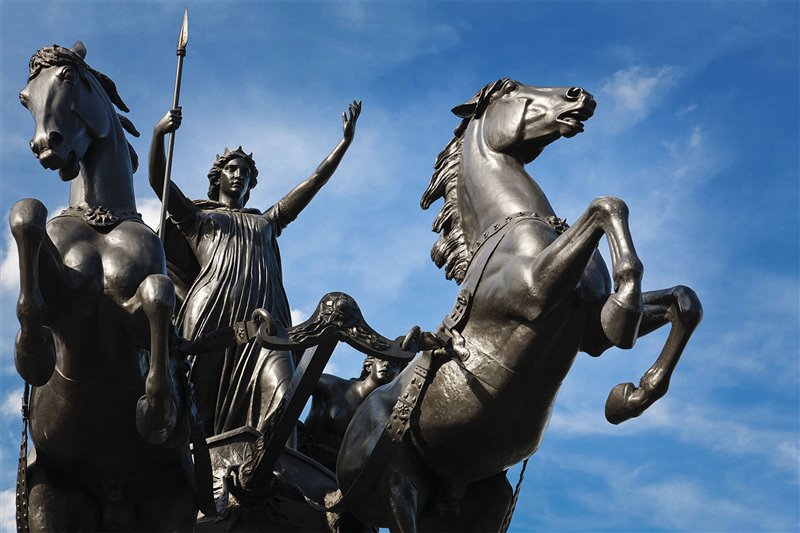Review
Boudica was a warrior queen of the Iceni who led several British tribes during the largest uprising in Britain against Roman occupation in 60-61 during the reign of Emperor Nero. He subdued the Roman 9th Legion and subsequently burned London (Londinium) almost to the ground. Boudica's rebellion was finally put down by the Roman governor Gaius Suetonius Paulinus. From the 19th century onwards, she became a symbol of resistance for the people of Britain and for suffragettes.
Justifications
- She led the uprising of several British tribes against the Roman occupation.
- Subdued the Roman IX Legion and subsequently burned London (Londinium) practically to the ground.
- Since the 19th century, it has become a symbol of resistance for the inhabitants of Great Britain.
- Exemplifies the political, military and social organisation of pre-Roman peoples.
- Was the symbol adopted by suffragettes in the marches of the National Union of Women's Suffrage Societies.
Biography
Two historians, Tacitus (in his Annals and in The Life of Julius Agricola) and Dion Cassius (in Roman History), provide us with basically all the data we have about her.
Boudica belonged to the Iceni, a Celtic tribe that inhabited the lands of eastern England. She descended from an aristocratic family and ascended to the throne through her marriage to Prasutagus, king of the Iceni, who in 43 became an ally of Rome and offered aid to the troops of Emperor Claudius in the conquest of Britain. In order to ensure the safety of his family and his people, the king drew up a will in which he named both his two daughters and Caesar as heirs to his kingdom.
For unknown reasons, Prasutagus died in 60 AD, and Rome quickly came to claim his inheritance. Relying on Roman law which, unlike Celtic customs, did not recognize the right of women to rule, the Romans devastated the Icenian kingdom, enslaved part of the population and seized all their property. Boudica rebelled and Rome responded brutally. The queen was flogged in front of her people and her two daughters were raped.
In 61, Boudica, with the help of the Trinovantes and other tribes opposed Roman domination and led an attack on the most Romanized urban centers such as Camulodunum (Colchester) and Londinium (London), the main Roman commercial enclave. That action, resulted in the defeat of the IX Legion and even Gaius Suetonius, one of Rome's best generals, governor of Britannia since 59 AD, was forced to flee Londinium. They destroyed and burned the cities and were furious with their inhabitants, whom they subjected -according to Tacitus and Dion Cassius- to the cruelest tortures.
After gathering the XIV Legion under his command, some soldiers of the twentieth and auxiliary troops from nearby territories, Suetonius decided to battle Boudica, who, despite having a much larger number of troops, was defeated thanks to Roman strategy, order and discipline. Numerous warriors died crushed by their own comrades or under Roman arms. Men, women and children were exterminated in an orgy of blood. The repression continued even after the battle, as Nero sent new troops to Britannia to put down any remnants of rebellion.
The end of Boudica is not known for sure. According to Dion Cassius, the queen fell ill after the battle and died shortly thereafter. Other sources claim that she took her own life to avoid being captured by the Romans. Her most loyal warriors accompanied her to her end, and gave her a grand funeral, keeping her burial place a secret.
Since the 19th century, it has become a symbol of resistance for the inhabitants of Great Britain and for the suffragettes in the marches of the National Union of Women's Suffrage Societies.
Summary of the article by Álvarez Díaz, Carolina (2016). “Boudica, la venganza de una reina”. Revista de historia, (retrieved on 5/01/2020) <https://revistadehistoria.es/boudica-la-venganza-de-una-reina/>
Bibliography
-Álvarez Díaz, Carolina (2016). “Boudica, la venganza de una reina”. Revista de historia, (retrieved on 05/01/2020), <https://revistadehistoria.es/boudica-la-venganza-de-una-reina/>
-Casio, Dion (2004). Historia Romana, Libro LXII. Madrid: Gredos.
-Pavón, Pilar (dir.) (2022). “Exposición Virtual: 250 mujeres de la antigua Roma” en Conditio feminae I: Marginación y visibilidad de la mujer en el Imperio Romano. Universidad de Sevilla, (retrieved on 21/11/2022), <https://grupo.us.es/conditiofeminae/index.php/2022/03/14/98-boudica/>
-Tácito (2008). Anales, Madrid: Alianza Editorial.
AUDIOVISUALS:
-"Boudica. La reina guerrera", in Documaniatv, (retrieved on 03/05/2021), <https://www.documaniatv.com/historia/boudica-la-reina-guerrera-video_03b97bc17.html>
Didactic approach
-Classical culture: Block Classical roots of today's world. History and socio-political evolution; Block Classical roots of today's world. Everyday life.
-Latin 4 ESO: Block The present of Latin civilisation.
-Latin Baccalaureate: Block Ancient Rome.
-History 1 ESO: Block Societies and territories, referring to Rome.
Documents
